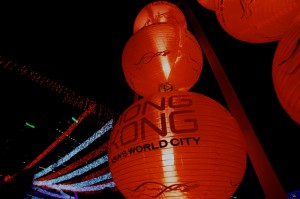The last time I was in ‘Honkers’ was back in 1979 and the Brits still owned the place.
Despite the change of landlord the number plates are still very British and the currency is still the Hong Kong Dollar.
Neon signs are now bigger and brighter and with the change in technology there’s now a giant plasma TV on every corner.
The Mid-Autumn Festival provided us with even more lights.
We went to Victoria Park where thousands queued patiently to visit the ‘Rising Moon.’ This 10 meter high light sculpture was made from recycled water bottles and changed colour to the rhythm of the accompanying music.
There have always been sky scrapers in Hong Kong, especially the apartment blocks that cling bravely to the coastline along the harbor. Now there are a few more larger ones showing off the Chinese love of stunning contemporary architecture. Unfortunately these have been built at the expense of the old Colonial buildings, that are now even harder to find.
The people are as friendly as ever and always willing to redirect a lost tourist. While most of the ‘Hard Yakka’ is still done by hand.
Transport is even more efficient now, with the introduction of the Octopus Card – it’s a Myki that actually works. The Star Ferry hasn’t changed since 1979, in fact I think that the same boats are still operating and run by the same old salty staff.
The taxi service is also a relic from last century and runs entirely with a fleet of Toyota Crown Comforts, again straight from the 1970s.
We did the usual Star Ferry crossing from Kowloon to Hong Kong Island and took the tram up to Victoria Peak. Here we did notice a change, the tram has been upgraded and the tourist centre on Victoria Peak, Peak Towers, is now a new chrome and glass complex. It was refurbished in 2006 and offers 360 degree views around the island.
As part of our ‘Rediscovering Hong Kong Adventure’ we walked around the Sheung Wan district. This is one of the oldest parts of the island and where the British first settled. There we found the Man Mo Temple, built in 1847 and, unfortunately for us, undergoing major renovations. Even here bamboo is still the preferred material for scaffolding.
On our final day we did the ‘Family Walk’ on Lamma Island from Yung Shue Wan to Sok Kwu Wan. Sadly the power station was our constant companion on the climb out of Yung Shue Wan.
The biggest change however was in the number of signs telling you what and what not to do. They were everywhere, on the beaches, parks, streets, monuments and transport, warning you of the dire consequences of running foul of the local authorities.
However, in their own charming way, the residents of Hong Kong managed to ignore them all.










